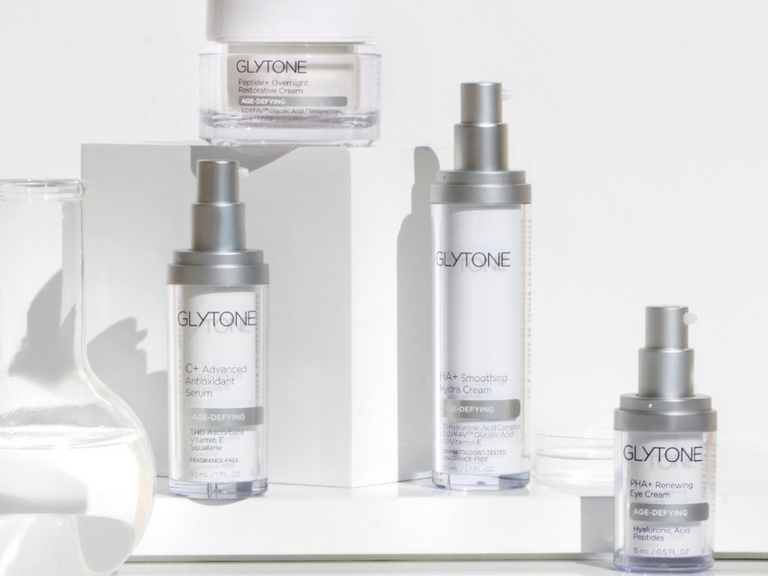You might have heard about hydrating hyaluronic acid or acne-clearing salicylic acid, but what about mandelic acid? This skincare ingredient can help with everything from hyperpigmentation to acne, wrinkles to dull skin. But is it right for you?
Here at Face Dr, our team of skin experts are dedicated to helping you take the best care of your skin. Our team has decades of experience in the skincare world and love sharing that knowledge. In this article, we’re doing to dive into what exactly mandelic acid does and whether you should add it to your skincare routine.
Here’s what we’ll cover:
- What mandelic acid is
- What mandelic acid does for the skin
- How mandelic acid works
- How to use mandelic acid
- Who should (and shouldn’t) use mandelic acid
- The side effects of mandelic acid
- The top products to try with mandelic acid
Interested in how other skincare ingredients work? Visit our blog.
What is mandelic acid?

Mandelic acid is a type of alpha hydroxy acid, or AHA, just like other acids you may already know like glycolic acid and lactic acid. It’s derived from bitter almonds and can be found in everything from cleansers to toners, peels to masks. It’s even in professional chemical peel treatments. Most often though, you’ll find it in a serum.
What does mandelic acid do for the skin?

Mandelic acid can leave your skin looking brighter, clearer and younger. It has become a go-to ingredient in the skincare world for a range of visible results. Here’s just a few of them.
Mandelic acid can:
- Even out skin tone
- Brighten the complexion
- Firm the skin and smooth wrinkles
- Lighten hyperpigmentation — even melasma and post-inflammatory hyperpigmentation
- Reduce breakouts and acne — even cystic acid
How does mandelic acid work?
Like other AHA, mandelic acid works as an exfoliator. It dissolves the bonds between dead skin so they can be sloughed off more easily. This reveals a more glowing complexion underneath. Discoloured skin cells are removed, reducing hyperpigmentation and leaving the skin looking brighter.
But the acid can do more than that. Mandelic acid almost boosts the production of collagen — the main protein in our skin — which plumps the skin, leaving it looking firmer and smoothing out the look of fine lines.
Mandelic acid can also regulate oil production and unblock pores. This helps to clear acne. The ingredient is also antibacterial and anti-inflammatory, both of which are great for those who experience acne or regular breakouts.
How do you use mandelic acid?
Depending on whether you try mandelic acid in a cleanser, mask or serum, changes how you’ll apply the product. You should always follow the instructions for the product you’re using.
For serums, where the ingredient is most common, you should apply a small amount of the product as part of your evening routine. Apply to dry skin after cleansing, avoiding the delicate skin around your eyes. Gently pat the product into your skin and wait a few minutes before applying your favourite moisturiser or night cream.
Who can use mandelic acid?

- All skin types
- All skin tones
- Pregnant people
- Those with nut allergies
Mandelic acid is suitable for every skin type, even those with very sensitive skin. The ingredient has the largest molecules out of any AHA — they’re twice the size of glycolic acid! This means it doesn’t penetrate the skin as deeply as other acids, making it less irritating and ideal for sensitive types.
For those with sensitive skin, you can start using mandelic acid once or twice a week and slowly increase this to the recommended amount of the product, which is usually once a day.
Mandelic acid is also safe for all skin tones, even darker ones. Where there’s a risk that other AHAs may cause pigmentation or lightening on darker skin tones, mandelic acid is so gentle that it’s safe to use.
Even though mandelic acid is made from a type of almond, most dermatologists agree that it is safe for people with nut allergies. To be safe, you should always patch test the product on a small amount of skin to check for a reaction or any irritation before using it fully.
If you’re trying to tackle hyperpigmentation, signs of ageing, dull skin or acne, mandelic acid may be perfect for you. Other acids, like glycolic acid, have proven more effective, but they’re also a lot harsher. So opt for mandelic acid if you have sensitive skin, a darker skin tone or you’ve tried other acids and have found them irritating or too drying. Mandelic acid is also great for those who are new to skincare acids and want to start with a gentle one.

Who can’t use mandelic acid?

Although mandelic acid can work well with salicylic acid for acne or glycolic acid for exfoliation, you need to get the balance right. You may not be able to use mandelic acid if your skincare routine already includes a lot of harsh products, like other acids, as this can cause irritation and damage the skin.
Speak to a skincare expert to find out if mandelic acid fits into your current routine. At Face Dr, we offer free consultations so you can not only get product recommendations, but get our skin experts’ help building a whole routine around this acid.
Just like with other AHAs, mandelic acid makes the skin more sensitive to the sun. You should therefore always wear an SPF to protect yourself from UV damage, and perhaps consider avoiding it altogether if you spend a lot of time outside in direct sunlight. For most of us, using a high-grade SPF is enough though.
Which ingredients should you avoid if you’re using mandelic acid?
As mandelic acid is a type of AHA, there are a few ingredients out there that you shouldn’t use at the same time.
First, you shouldn’t combine it with a retinol product. The ingredients are too harsh and may cause irritation, dryness and flakey patches. The same goes for other AHAs and exfoliating acids. While it can be tempting to combine all of the key skincare ingredients out there, our skin simply can’t handle that much exfoliation. If you’re looking for multiple benefits, look for products that combine the acids, as they’ll get the percentage right, or speak with a skincare expert to tell you the best way to tackle your concerns with multiple ingredients.
You should also avoid using vitamin C and niacinamide if you’re using an AHA. While this isn’t harmful, the AHA will change the pH of the vitamin C or niacinamide, making them much less effective. Basically, they can cancel each other out. That doesn’t mean you can’t use them altogether though, just use them at a different point in your skincare routine, like morning and night or on different days.
What are the side effects of mandelic acid?
Most people won’t experience any side effects from mandelic acid, and those that do usually only experience mild irritation. However, some people may have side effects including:
- Redness
- Itching sensations
- Irritated skin
- Peeling
You should stop using mandelic acid immediately and speak to a professional if it’s a serious reaction. If it’s minor, it should go away on its own and it may be due to overuse. You can try reducing the amount of times a week you use the product to see if it helps.
We always recommend doing a patch test of any new product to see if your skin reacts before applying it to your face.
If you have very sensitive skin or are nervous about a reaction, you can speak to one of our skin experts who can analyse your skin and give you expert advice on whether mandelic acid is for you before you try it.
Products to try with mandelic acid
Here's our recommendation of products containing mandelic acid:

Face Dr top pick: ZO Skin Health Oil Control Pads Acne Treatment

Face Dr top pick: Glytone Mandelic Gentle Resurfacing Serum
You could also try:
- Dr Dennis Gross Alpha Beta Pore Perfecting Cleansing Gel
- The Ordinary Mandelic Acid 10% + HA
- Medik8 Pore Cleanse Gel Intense
Looking for some expert advice?
Curious about what mandelic acid can do for your skin, but not sure where to start? Why not speak to a skincare professional to see if this ingredient is right for you. At Face Dr, we offer free online skincare consultations where you can speak to a member of our friendly team.
In 30 minutes, we’ll analyse your skin and ask about your exact skincare concerns to see if mandelic acid can help. We can also recommend the best products with the ingredient and even help you build the ideal skincare routine using it.
We only ever recommend brands we know and trust, and there’s never any obligation to buy, so you can trust you’re getting the very best advice for your skin.








